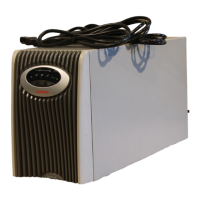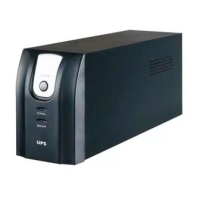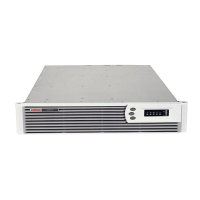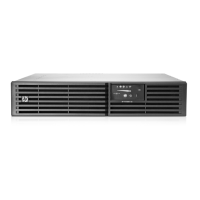Do you have a question about the HP T1000 XR and is the answer not in the manual?
| Output Power Capacity (Watts) | 900 Watts |
|---|---|
| Topology | Line Interactive |
| Rack Height | 2U |
| Waveform Type | Sine Wave |
| Nominal Output Voltage | 230V |
| Nominal Input Voltage | 230V |
| Typical Backup Time at Half Load | 15 minutes |
| Interface Port | USB |
| Device Type | UPS |
| Input Voltage | 230V |
| Output Voltage | 230V |
| Frequency | 50/60 Hz |
| Waveform | Sine Wave |
| Typical Recharge Time | 3 hours |
| Operating Temperature | 0 to 40°C |
| Storage Temperature | -15 to 45°C |
| Relative Humidity | 0 to 95% non-condensing |
| Output Power Capacity | 1000 VA |
| Input Connection | IEC C14 |
| Battery Type | Sealed Lead Acid |
| Transfer Time | 4 ms |
| Dimensions | 438 x 89 x 482 mm |
Defines the intended audience for this user guide and their expected qualifications.
Advises reading the included safety document before installing the UPS.
Explains symbols on the equipment indicating potential hazards.
Defines symbols used within the text for warnings, cautions, and important notes.
Lists other HP documents providing additional information on related topics.
Provides guidance on where to find further assistance if problems are encountered.
Details how to contact HP Technical Support and required information.
Directs users to the HP website for product information, drivers, and updates.
Provides contact information for locating the nearest authorized HP reseller.
Provides an email address for users to submit comments or feedback on the guide.
Lists the versatile and user-friendly features of the HP UPS.
Describes the port for data exchange between the UPS and a host computer.
Explains the function of the NTP for surge protection of connected communication devices.
Details the different UPS models available for T1000 XR and T1500 XR.
Shows and describes the front panel configuration of the UPS.
Illustrates and labels the rear panel configurations for various UPS models.
Explains the functions of the power management software for UPS control.
Lists available hardware options for expanding UPS capabilities.
Details the three-year limited warranty and guarantees for the UPS.
Describes the additional guarantee offered for connected equipment in North America.
Explains the warranty coverage for batteries before they actually fail.
Describes the front panel controls and LED indicators for UPS monitoring and configuration.
Explains the three modes of operation: Standby, Operate, and Configure.
Details how the UPS batteries are charged and important charging times.
Provides instructions on how to put the UPS into Operate mode.
Provides instructions on how to return the UPS to Standby mode.
Instructions to initiate a self-test for checking battery status and UPS health.
Information regarding audible alarms and their meaning.
Describes how to silence an audible alarm using the Test/Alarm Reset button.
Provides step-by-step instructions for properly shutting down the UPS system.
Instructions on how to enter the UPS's Configure mode.
Details the UPS configuration parameters and their respective meanings.
Lists the available voltage settings for different UPS models.
Step-by-step guide on how to change the UPS configuration settings.
Important safety precautions for handling UPS batteries.
Guidance on identifying when UPS batteries require replacement.
Information on where and how to purchase replacement battery packs.
Outlines the options available for replacing UPS batteries.
Steps to prepare the UPS before proceeding with battery replacement.
Instructions on how to remove the battery bracket for access.
Step-by-step guide to removing the battery pack from T1000 XR models.
Step-by-step guide to removing the battery pack from T1500 XR models.
Instructions for installing a new UPS battery pack.
Guidance on how to test the newly installed battery pack.
Information on proper procedures for disposing of used UPS batteries.
Tips for maximizing battery life through proper care and storage.
Details the warranty coverage for batteries before they actually fail.
Provides solutions for problems encountered when starting the UPS.
Offers solutions for issues that arise after the UPS has started.
Information on how and where UPS repairs can be performed by authorized personnel.
Explains the purpose and location of unique series numbers for compliance.
Details FCC rules regarding RF emissions and device classification.
Describes compliance for Class A digital devices operated in commercial environments.
Describes compliance for Class B digital devices operated in residential environments.
States FCC compliance conditions and provides contact information.
Warns against unauthorized modifications to the device that could void authority.
Specifies requirements for connecting shielded cables for FCC compliance.
Compliance information for Canadian regulations, Class A and B.
Details CE Marking compliance with EMC and Low Voltage Directives.
Provides VCCI compliance information for Japanese users.
Warning for users in China and Taiwan regarding potential RF interference.
Warns about battery replacement hazards and proper disposal procedures.
Advises on precautions to prevent damage from static electricity.
Describes various methods for proper grounding to prevent ESD.
Provides physical dimensions and weight for T1000 XR and T1500 XR models.
Details input voltage, frequency, and power cord specifications for different models.
Lists output VA, wattage, load segments, and receptacle types.
Provides technical specifications for the batteries used in T1000 XR and T1500 XR models.
Lists operating and non-operating environmental conditions for the UPS.











